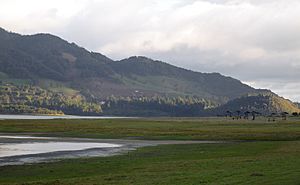Muisca agriculture facts for kids


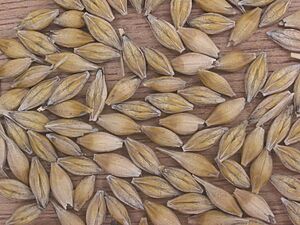
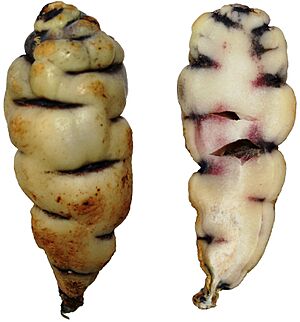
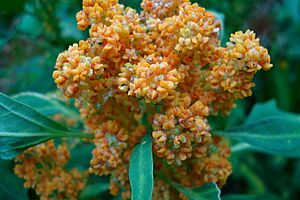
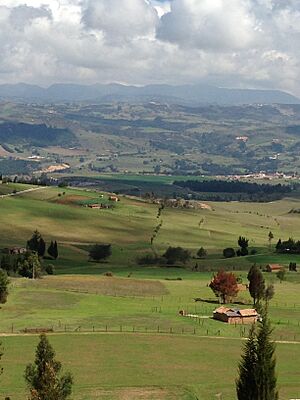
The Muisca agriculture describes how the Muisca people grew their food. They were an advanced civilization living in the Colombian Andes mountains, on a high plateau called the Altiplano Cundiboyacense, before the Spanish arrived.
The Muisca mostly farmed. They had small fields that were part of bigger areas of land. To get different kinds of food, they traded things like blankets, gold, emeralds, and salt. In return, they received fruits, vegetables, coca, yopo, and cotton. These items were grown in warmer, lower areas by their neighbors, including the Muzo, Panche, Guane, Guayupe, Lache, Sutagao, and U'wa. They also traded with people farther away, like the Calima and Pijao, and communities near the Caribbean coast.
Contents
How Farming Began
People have lived in the central Colombian Andes for a very long time, over 12,000 years ago! Early people were hunter-gatherers, meaning they hunted animals and gathered wild plants for food.
Around 4,000 to 3,000 BCE, some of the first signs of farming in South America appeared in Colombia. At this time, people started to leave their rock shelters and live on the open plains of the Altiplano Cundiboyacense, especially in the southern part called the Bogotá savanna.
Between 1500 and 1000 BCE, the Muisca diet started to include more maize (corn). By 1000 BCE, maize was the main food for the Muisca. Around 750-800 BCE, maize farming became even more common. This time is known as the Herrera Period. During the Early Herrera Period, around 500 BCE, people also started using ceramics (pottery) a lot. Scientists think these changes happened because new groups of people moved into the area.
The Herrera Period was followed by the Early Muisca Period (around 800 AD to 1200 AD). Then came the Late Muisca Period (1200 AD until the Spanish conquest). The main difference between these periods was how the Muisca groups were organized and how much the population grew. During the Late Muisca Period, the people were part of a loose group of different leaders. The most important leaders were the zipa in Bacatá and the zaque in Hunza. Other leaders, called caciques, ruled smaller villages.
Muisca Farming Practices
The Muisca lived mainly on the plains and in the valleys, which made up about 12% of their land. There were also smaller communities in the mountains. The valleys, especially the Bogotá savanna, used to be an ancient lake. This meant the soil was very rich and good for growing many different crops.
The Muisca farmed on small fields. Everyone, no matter their social class, had access to enough food. The main differences between social classes were their houses and how much meat they ate.
The most important crop for the Muisca was maize (corn). They even had many different words in their language, Muysccubun, for the plant, its kernels, and how they prepared it. We know maize was grown even before the Muisca, during the Herrera Period, by studying plant pollen. The Muisca groups were able to grow enough food for themselves. They traded extra maize (called abitago) for tropical fruits like pineapples, avocados, and sweet potatoes.
The Muisca built terraces on the often-flooded highlands to farm. They also created systems to bring water to their fields (irrigation) and drain it away. They planted their crops in rows of small mounds.
Men were in charge of harvesting the crops and preparing the fields. Women did the sowing (planting the seeds). The Muisca believed that the women's fertility would help the crops grow better. To make the fields even more fertile, farmers would burn plants and spread the ash over their land.
Farming After the Spanish Arrived
After the Spanish conquered the Muisca lands, things changed a lot. Not only did their government and religion change, but also their farming. The Muisca quickly started growing crops from the Old World (Europe, Asia, Africa). This happened fast because the fertile lands of the Altiplano Cundiboyacense were perfect for European crops. In 1555, the Muisca in Toca were already growing European crops like wheat and barley. Sugarcane was also grown in other areas.
Main Crops Grown by the Muisca
Besides maize, the Muisca grew many other important plants:
- Achira, one of the first plants grown in the Andes.
- Arracacha, a root vegetable that grows well at higher altitudes.
- Cubio, another root vegetable, grown in very high areas.
- Oxalis tuberosa, a root that came from Peru.
- Ulluku, a type of potato.
- Polymnia edulis.
- Different types of potatoes, including Solanum tuberosum, Solanum colombianum, and Solanum andigena.
- Yuca (manioc), a very important root vegetable grown since 1120 BCE.
- Sweet potatoes, found in the area as early as 3,200 years ago.
- Quinoa, a grain that came from Peru, grown for over 5,000 years.
- Common beans, first grown in Mexico, Central America, Peru, and Colombia.
- Peanuts.
- Pumpkins and Curcubita pepo, with the earliest evidence from 3860 BCE.
- Uchuva, a typical Colombian fruit, grown at high altitudes.
- Lulo, the national fruit of Colombia.
- Many types of passionfruits, like P. mixta and P. quadrangularis.
- Tree tomato.
- Cherimoya, soursop, and sugar apple.
- Vaccinium meridionale.
- Different types of blackberries, like R. macrocarpus.
Farming and Muisca Religion
In the Muisca religion, the god of fertile farm fields and people was named Chaquén. During planting and harvest times, people would gather to honor Chaquén. At these celebrations, which followed the Muisca calendar, they would drink chicha, an alcoholic drink made from fermented maize and sugar.
Place Names from Farming
Many place names in the Muisca lands are related to farming. The Muisca word tá means "farm field." For example, the old capital of the southern Muisca was Bacatá (which is where Bogotá gets its name). Other examples include Chitaraque, Chivatá, Cucaita, Guayatá, Soatá, Socotá, Tota, Machetá, Manta, Quetame, and Tabio.


